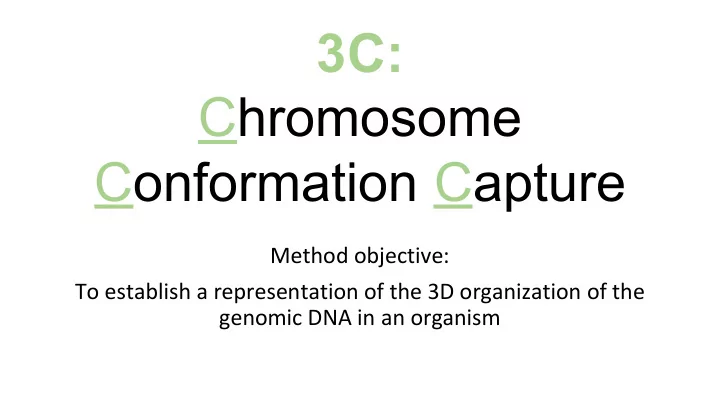

3C: Chromosome Conformation Capture Method objective: To establish a representation of the 3D organization of the genomic DNA in an organism
● Proteins mediate interactions between segments of DNA such as enhancers interacting with promoters.
1. Cross-linking ● This chromatin conformation is captured by linking the interacting chromatin together. ● Fixative reagent: formaldehyde
2. Digestion ● The fixed chromatin is cut with a restriction enzyme recognizing 6 bp. ● Important: the restriction enzyme has to be appropriate for the digestion desired.
3. Religation ● The sticky ends are religated under dilute conditions to promote religation of intramolecular fragments. ● Creates a single fragment of DNA that interact but may be far away on the linear template.
4. Reverse cross-linking ● To reverse the cross- link, the temperature is raised. ● The result is a 1D print of the 3D nuclear structure.
5. Quantification ● Quantitative PCR (qPCR) - use fluorescent reporter, which permits detection after primer hybridizes to sequence of interest ● Measure amount of ligation product over linear qPCR product formation using the fluorescent probe ● Primers designed near and toward the ends of the restriction site of interest.
6. Comparison ● Perform quantitative PCR (qPCR) on multiple ligated restriction VI fragments VII ● Divide these qPCR results by those V obtained in the control experiments IV to obtain relative cross-linking II IX VIII XI I X XII XIII frequency III ● Plot these relative cross-linking frequencies against a map of the chromosome or segment in question
Background for Question Depiction of the ß -globin locus in mice ● The black arrows correspond to the Ɛɣ and ßh1 genes, which are inactive in fetal brain and liver cells , while the red arrows correspond to the ß maj and ß min genes, which are active in fetal liver cells, but inactive in fetal brain cells ● The shaded regions containing a given roman numeral represent restriction fragments ● The red dots correspond to DNaseI hypersensitivity (HS) sites. HS sites 1-6 represent the ß-globin locus control region (LCR), which is known to enhance the expression of active ß-globin genes ● Relative cross-linking frequencies observed in fetal liver cells are shown in red, while those in fetal brain cells are shown in blue
Question With all of the relevant information given, decide which of the following statements are true. 1. If we wanted to examine the interaction of the HS sites in the LCR with the ß-globin genes more precisely, we would need to use restriction enzymes that cut this section of the ß-globin locus more frequently. 2. If relative cross-linking frequencies are roughly monotone decreasing as we move from adjacent fragments on the chromosome to more distant fragments on the chromosome, this suggests a linear chromosome conformation. For this reason, the ß-globin locus in brain cells appears to have a roughly linear conformation. 3. The LCR (fragments IV-VI), a known enhancer, is in closer spatial proximity to active ß-globin genes than inactive ß-globin genes. 4. If fragments II and IV had relative cross-linking frequencies greater than 1, this would imply that they were in closer spatial proximity to one another compared to if the ß-globin locus were linear in conformation. 5. The fact that fragment III has similar relative cross-linking frequencies in both fetal liver and brain cells with both inactive and active b-globin genes implies that it is not in close spatial proximity to such genes via loop formation.
Recommend
More recommend